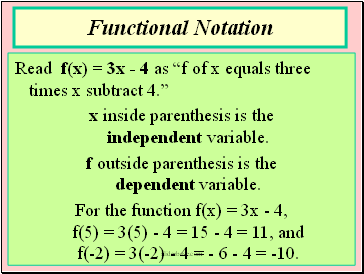Functions and GraphsPage
1
1
Slide 1
PRECALCULUS I
Dr. Claude S. Moore Danville Community College
Functions and Graphs
Function, domain, independent variable
Graph, increasing/decreasing, even/odd
Slide 2
Definition: Function
A function f from set A to set B is a rule of correspondence that assigns to each element x in set A exactly one element y in set B.
Set A is the domain (or set of inputs) of the function f, and set B contains range (or set of outputs).
Slide 3
Characteristics of a Function
1. Each element in A (domain) must be matched with an element of B (range).
2. Each element in A is matched to not more than one element in B.
3. Some elements in B may not be matched with any element in A.
4. Two or more elements of A may be matched with the same element of B.
Slide 4
Functional Notation
Read f(x) = 3x - 4 as “f of x equals three times x subtract 4.”
x inside parenthesis is the independent variable.
f outside parenthesis is the dependent variable.
For the function f(x) = 3x - 4, f(5) = 3(5) - 4 = 15 - 4 = 11, and f(-2) = 3(-2) - 4 = - 6 - 4 = -10.
Slide 5
Piece-Wise Defined Function
A “piecewise function” defines the function in pieces (or parts).
In the function below, if x is less than or equal to zero, f(x) = 2x - 1; otherwise, f(x) = x2 - 1.
Slide 6
A function f from set A to set B is a rule of correspondence that assigns to each element x in set A exactly one element y in set B.
Set A is the domain (or set of inputs) of the function f, and set B contains range (or set of outputs).
Definition: Function
Slide 7
Piece-Wise Defined Function
A “piecewise function” defines the function in pieces (or parts).
In the function below, if x is less than or equal to zero, f(x) = 2x - 1; otherwise, f(x) = x2 - 1.
Slide 8
Domain of a Function
Generally, the domain is implied to be the set of all real numbers that yield a real number functional value (in the range).
Some restrictions to domain:
1. Denominator cannot equal zero (0).
2. Radicand must be greater than or equal to zero (0).
3. Practical problems may limit domain.
Slide 9
Domain of a Function
1 2
Contents
- Definition: Function
- Characteristics of a Function
- Functional Notation
- Piece-Wise Defined Function
- Piece-Wise Defined Function
- Domain of a Function
- Domain of a Function
- Summary of Functional Notation
- Vertical Line Test for a Function
- Even and Odd Functions
Last added presentations
- Space Radiation
- Radiation
- Mechanics Lecture
- Simulation at NASA for the Space Radiation Effort
- Buoyancy
- The Effects of Radiation on Living Things
- Radioactivity and Nuclear Reactions






